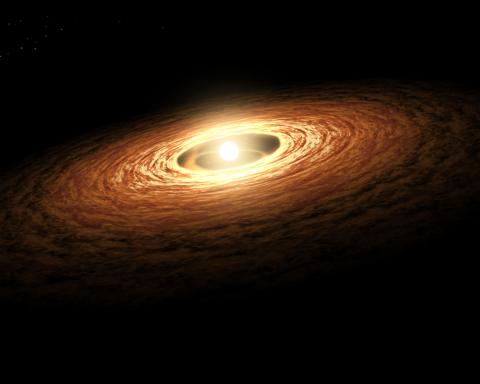
JWST finds more hydrocarbons in discs around very low-mass stars
An international research team involving scientists from Université Paris-Saclay, the French National Centre for Scientific Research (CNRS), the French Alternative Energies and Atomic Energy Commission (CEA), Ecole Polytechnique and the Observatoire de Paris have just unveiled the chemical composition of a rotating disc of gas and dust around a young star, where new planets are formed. The results reveal the richest hydrocarbon chemistry seen to date in a protoplanetary disc, and provide insights into the potential composition of planets which form around the star. The results, which were published in Science on Thursday 6 June, were obtained as part of a programme for the mid-infrared instrument MIRI, which was developed by a consortium of laboratories in Europe and the United States, and includes Université Paris-Saclay.
Rocky planets are common around very-low mass stars, as demonstrated by the well-known planetary system TRAPPIST-1. And yet, we know little about the chemistry of these worlds, which can be similar or very different to Earth. By studying the discs from which these planets are formed, known as protoplanetary discs, astronomers hope to gain a better understanding of how these planets form and their composition.
Protoplanetary discs around very low-mass stars are difficult to study because they are smaller and not as bright as discs orbiting larger stars. The MIRI Mid-INfrared Disk Survey (MINDS) aims to use the unique capabilities of the James Webb Space Telescope (JWST) to build a bridge between the chemical inventory of discs and the properties of exoplanets.
In a new study, the team explored the region around a very low-mass star of 0.11 solar masses (known as ISO-ChaI 147). The spectrum revealed by Webb’s Mid-InfraRed Instrument (MIRI) shows the richest hydrocarbon chemistry seen to date in a protoplanetary disc, consisting of 13 carbon-bearing molecules. This includes the first extrasolar detection of ethane (C2H6), ethylene (C2H4), propyne (C3H4), and the methyl radical CH3.
“It is incredible that we can detect and quantify the amount of molecules that we know well on Earth, such as benzene, in an object that is more than 600 light-years away,” said Agnès Perrin, a CNRS researcher at the Laboratoire de Météorologie Dynamique (LMD - CNRS/ENS-PSL/IPP/Sorbonne Université).
“Last year, we had already discovered a large quantity of acetylene (C2H2), diacetylene (C4H2) and benzene (C6H6) in a disc around a similar star. This discovery is an even richer cocktail of molecules, confirming that discs surrounding this type of star are genuine hydrocarbon factories,” added Benoît Tabone, a CNRS researcher at the Institut d’Astrophysique Spatiale (IAS - Université Paris-Saclay/CNRS).
These results have major implications for planet formation. As JWST has shown that the gas present in the disc is carbon-rich, it is likely that little carbon is left in the solid materials from which planets may form. As a result, the rocky planets which may form there could be carbon-poor, just like Earth.
This work highlights the crucial need for scientists to collaborate across disciplines. The team notes that these results and the accompanying data can contribute towards other fields including theoretical physics, chemistry and astrochemistry, to interpret the spectra and to investigate new features in this wavelength range.
Read the full press release issued by the European Space Agency (ESA): https://esawebb.org/news/weic2416/
Access the article published in Science: https://www.science.org/doi/10.1126/science.adi8147
Contact for Université Paris-Saclay
Benoît Tabone, Institut d'Astrophysique Spatiale (IAS - Univ. Paris-Saclay/CNRS) : benoit.tabone@universite-paris-saclay.fr
